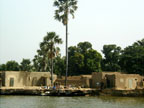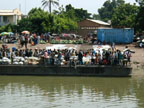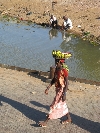| |
  The
boat departs well after dark so it is many hours, a good night sleep and a
sunrise later before you get a chance to see what the world looks like from
central river. By the time that it is light enough to distinguish
shapes on the river there are the canoes of fisherman scattered about.
They probably rose well before sunrise. The
boat departs well after dark so it is many hours, a good night sleep and a
sunrise later before you get a chance to see what the world looks like from
central river. By the time that it is light enough to distinguish
shapes on the river there are the canoes of fisherman scattered about.
They probably rose well before sunrise.


  As
the morning lighting grows you begin to realize how populated the river
banks are, and likely were all night when everything hid in plane sight in
the darkness. Perched at the boats rail, it is moving art gallery watching
the villages glide by. The bigger ones are distinguished with a dramatic and
distinctly designed clay mosque towering above all other structures.
Increasingly the villages come alive and more people come down to the waters
edge to wash and play. As
the morning lighting grows you begin to realize how populated the river
banks are, and likely were all night when everything hid in plane sight in
the darkness. Perched at the boats rail, it is moving art gallery watching
the villages glide by. The bigger ones are distinguished with a dramatic and
distinctly designed clay mosque towering above all other structures.
Increasingly the villages come alive and more people come down to the waters
edge to wash and play.
  Looking
down from the boat it feels like the boat is one with the river. Unless you
look at the riverbank it is difficult to judge how fast we are traveling --
we are going down stream -- but on careful examination it is clear we are
making progress -- the Niger has a pretty good flow rate at this time of
year. Every few kilometers there is a village visible from the river --
there is no way of Looking
down from the boat it feels like the boat is one with the river. Unless you
look at the riverbank it is difficult to judge how fast we are traveling --
we are going down stream -- but on careful examination it is clear we are
making progress -- the Niger has a pretty good flow rate at this time of
year. Every few kilometers there is a village visible from the river --
there is no way of
 knowing
how many villages there are just back from the river. knowing
how many villages there are just back from the river.

On the boat, not quite as quickly, people rise too.
 As the people get breakfast so do the animals -- they boarded in
Koulikoro but I don't know their final destination. As the people get breakfast so do the animals -- they boarded in
Koulikoro but I don't know their final destination.
  About midday we
called on Segou. The waterfront was busy with boat delivering
passengers, sand, wood, produces and various other materials. About midday we
called on Segou. The waterfront was busy with boat delivering
passengers, sand, wood, produces and various other materials.
The dock was stacked with watermelons and the riverbanks were lined
with people washing, cloths, babies and bodies. Upland areas were
stacked with firewood, construction sand and other commodities that
were obviously brought in by boat. The boat stops longer here so there
is time to get off and look around.
  Prior to the French arriving in the 19th century Segou
was one of the capitol of the 17th and 18th century Kingdom by the same name. The French
also used it as a capitol for a while. The tree lined streets and some
taller French-style architecture in the older part of town separate Segou
from most others of its size. Prior to the French arriving in the 19th century Segou
was one of the capitol of the 17th and 18th century Kingdom by the same name. The French
also used it as a capitol for a while. The tree lined streets and some
taller French-style architecture in the older part of town separate Segou
from most others of its size.
   We
spent a majority of our shore time meeting some of the merchants in
the market and learning about the different kinds of beautiful fabrics
(woven, batik, dyed, painted) that are produced in the region and
conjecturing about the uses of some of the bird and animal parts and We
spent a majority of our shore time meeting some of the merchants in
the market and learning about the different kinds of beautiful fabrics
(woven, batik, dyed, painted) that are produced in the region and
conjecturing about the uses of some of the bird and animal parts and
 plant materials that are in the traditional
medicine section of the market. By the time we returned to the boat
most of the watermelon had disappeared, presumably into the hull of
the boat. Single melons were available for purchase so a couple were
bought for the group. plant materials that are in the traditional
medicine section of the market. By the time we returned to the boat
most of the watermelon had disappeared, presumably into the hull of
the boat. Single melons were available for purchase so a couple were
bought for the group.
  Afternoon is a leisurely time
on the cruise ship. People retreat to books, journals, card
games and the shade to pass the time as life on the river passes in
front them. It
is highly probable that the people sunbathing were tourists because it
isn't typical to see Malians laying in the sun. I periodically revert to
being a birder and occupy
myself Afternoon is a leisurely time
on the cruise ship. People retreat to books, journals, card
games and the shade to pass the time as life on the river passes in
front them. It
is highly probable that the people sunbathing were tourists because it
isn't typical to see Malians laying in the sun. I periodically revert to
being a birder and occupy
myself
 trying to distinguish between different models of heron, egret,
kingfisher, plover, weaverbird, scavengers, etc. trying to distinguish between different models of heron, egret,
kingfisher, plover, weaverbird, scavengers, etc.    
 Just before dusk we passed through a canal that lead to a lock. For
miles along the canal were checker-board vegetable gardens, mostly
growing onions. Who eats all of these onions. [Ed: Later we
would see many more acres of onions in cultivation in the center of the
Dogon country.] Just before dusk we passed through a canal that lead to a lock. For
miles along the canal were checker-board vegetable gardens, mostly
growing onions. Who eats all of these onions. [Ed: Later we
would see many more acres of onions in cultivation in the center of the
Dogon country.] At the locks, as the boat is lowered there is a trading frenzy between produce sellers
on the land and buyers on the boat. It goes on until the two groups
are out of reach. Much of the produce is destined for more arid and
remote destinations along the river like Timbuktu. Very animated
trading is the norm for every stop.
  Sunset
brought another cluster of photo opportunities. Even after dark the
boat would stop and villages and the residents would come out to our boat in
canoes to load and off-load people and goods. And, yes, sometimes
something would end up in the water, but not as often as if I was the oarman. Sunset
brought another cluster of photo opportunities. Even after dark the
boat would stop and villages and the residents would come out to our boat in
canoes to load and off-load people and goods. And, yes, sometimes
something would end up in the water, but not as often as if I was the oarman. |
Addendum: From our stroll through Segou comes this picture of women
pounding grain.

Unexplainably, when we arrived in Segou in '09 the dock was almost empty of
people and goods staged for loading. I am trying to figure out if it
was significantly earlier or later in the season, which might explain the
differences.

It's interesting to note the construction
techniques in Segou.

|

 The
boat departs well after dark so it is many hours, a good night sleep and a
sunrise later before you get a chance to see what the world looks like from
central river. By the time that it is light enough to distinguish
shapes on the river there are the canoes of fisherman scattered about.
They probably rose well before sunrise.
The
boat departs well after dark so it is many hours, a good night sleep and a
sunrise later before you get a chance to see what the world looks like from
central river. By the time that it is light enough to distinguish
shapes on the river there are the canoes of fisherman scattered about.
They probably rose well before sunrise.






























